

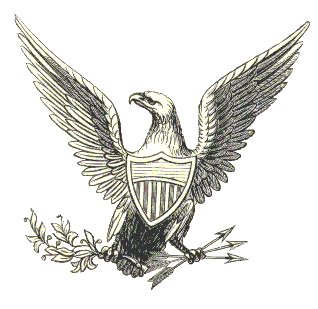 |
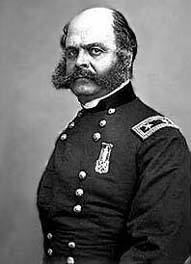 |
 |

CIVIL WAR UNIT HISTORY
The First Regiment Rhode Island
Rhode Island Adjutant General's Report
On the 12th day of April, 1861, rebellion against the government of the United States assumed a positive form, by the bombardment of Fort Sumter, then occupied by a single company, under the command of Major Robert Anderson, who bravely maintained his position upwards of thirty hours, when, overpowered by raging flames within the fort, and an overwhelming assaulting force, he was compelled to surrender. On the 15th of the same month, the President of the United States made a call upon the States for seventy-five thousand men, to serve three months in suppressing this outbreak of treason; and on the day following, in response to this call, an order was issued by Governor Sprague for an immediate organization of the First Regiment. Great activity prevailed in the Adjutant General's and Quartermaster General's Departments, and among our citizens generally, and in a few days the organization was completed. The Regiment proceeded to Washington in two detachments: the first, under Colonel Ambrose E. Burnside, leaving Providence April 20th, and the second, under Lieutenant Colonel Joseph S. Pitman, on the 24th. On the 19th, the day before the embarkation of the first detachment, a beautiful national flag was presented to the Regiment by the ladies of Providence, which waved over its marching column during the campaign, and at the Battle of Bull Run was perforated by eleven rebel bullets. A set of Regimental Colors for the Regiment was procured and forwarded by natives and citizens of Rhode Island, resident in California. They were sent to the care of Mayor Cranston, of Newport, and by him presented to Colonel Burnside, with appropriate ceremonies, at a public meeting in that city, October 29th, 1861, who in turn presented them to the members of Company F, the color company of the regiment, for preservation as a part of its history.
Both detachments left their encampment in Providence with the warm benedictions of the immense throngs that lined the streets and crowded the wharves and shipping to witness their departure. On arriving at Washington, quarters were provided for a short time at the Patent Office, and subsequently the Regiment was established at Camp Sprague, a beautiful grove with ample parade ground, in the vicinity of the city, where the time was devoted to improvement in discipline and drill. The encampment was planned by Lieut. Henry A. DeWitt, of the Engineers. The huts were built under the superintendence of Colonel William Goddard and Lieut. William E. Walker. These accommodations added greatly to the comfort and health of the men, a point that Colonel Burnside kept constantly in view. On the 9th of June, a company of Carbineers, to act as skirmishers, consisting of seventy-three privates was organized, of which Francis W. Goddard was commissioned Captain. The other officers were Walter B. Manton, Lieutenant, and Sergeants John B. Campbell, George 0. Gorton, Robert H. Doming, Louis T. Hall and Peleg E. Bryant. They were armed with Burnside rifles, and drilled by Lieutenant Henry T. Sisson, Paymaster of the Regiment. Previous to their organization as a separate corps, they were drilled by Lieutenant Charles E. Patterson, of the 4th U. S. Infantry. James Alien, of the Light Battery, and William H. Heime of Company C, were authorized to act aeronauts in connection with the movements of the Regiment. An accident to their two balloons frustrated their plans for aerial reconnaissance. |
"If Mr. Lincoln's needs are such, I may let him borrow my army". RI Governor William Sprague |
 |
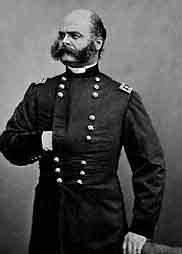 |
 |
Images Left to Right: |
The interest in the Regiment, by friends at home, did not expend itself in impassioned farewells at its departure, but followed it through its entire absence, and almost daily packages and boxes were received in camp, as tokens of kindly remembrance. A cargo of ice, the gift of forty-four citizens and firms in Providence, was sent in May to the Regiment by the schooner "Sea Gull", Captain Howland, Messrs. Earl Carpenter & Sons and the Providence Ice Company being among the principal contributors. The vessel arrived at Washington May 27th, and the welcome contribution was gratefully acknowledged by Colonel Burnside, on behalf of the Regiment, as was also a donation of five hundred copies of the New Testament and Psalms from the Rhode Island Bible Society, and numerous other gifts from generous friends. The enterprise was inaugurated by Mr. John Kendrick, and carried forward to its final success by the persistent labors of himself and Mr. Earl C. Potter. They, with twelve other gentlemen, accompanied the vessel as a guard, and rendered efficient aid in the distribution of the cargo.
The evening services at dress parade, conducted by the two chaplains, Protestant and Catholic, were highly impressive, and were frequently attended by President Lincoln and family, cabinet officers, members of the diplomatic corps, representatives and senators in congress, and other distinguished persons. The Sunday services were no less attractive and profitable; while week-day evening meetings, inaugurated mainly through the exertions of Lieutenant Prescott, contributed largely to preserve the religious habits of men surrounded by influences not always favorable to Christian thought or life. |
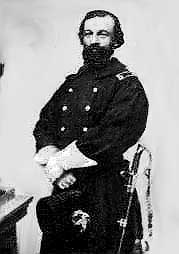 |
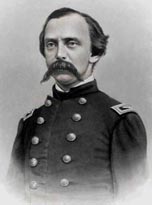 |
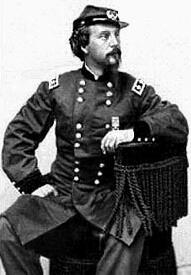 |
Images Left to Right: |
As troops continued to arrive in Washington, and the aspect of affairs assumed an increasingly serious hue, Union forces were thrown across the Potomac, and fortifications were erected on the heights stretching from Georgetown to Alexandria. For convenience in crossing the river, new ferries were established, and old ones guarded and worked. In this duty a detail of twenty-six men from the First Regiment, under Ensign Levi Tower, participated; and when, on the day of the funeral of Colonel Ellsworth, assassinated at Alexandria, an alarm of an engagement progressing on the Virginia side of the Potomac, was raised, the Regiment was instantly in line, ready to march on the moment of receiving orders. The alarm proved, however, to be without foundation, and quietness soon again reigned in camp.
On the 10th of June, the regiment marched on an expedition towards Harper's Ferry, preceded the day before by the Battery attached to it, to join other forces under General Patterson, for the purpose of dislodging the rebels under General Joseph E. Johnston, then holding that place. The expedition was accompanied to Greencastle by ex-Governor Elisha Dyer, Sr. of Providence, who rendered timely and efficient service. The Regiment was here joined by Governor Sprague, accompanied by his Aide-de-Camp, Colonel John A. Gardner. It advanced to Williamsport, in the State of Maryland, but the evacuation of Harper's Ferry by General Johnston rendered the further prosecution of the campaign unnecessary, and in obedience to orders received from Washington, the Regiment returned to that city, and on the 20th of June was established once more at Camp Sprague. The excessive heat and clouds of dust rendered the marching on this expedition exceedingly fatiguing, but the discomforts were borne with cheerfulness. It was on this occasion that the Regiment made a march of thirty-three miles in a single day, and ''in half an hour from the time the head of the column arrived at the encampment, every straggler had found his proper place in his company bivouac".
The rebels had been gradually accumulating at Manassas, threatening Washington; and early in July, Union forces had been collected in and around the National Capital in sufficient numbers to authorize an aggressive movement. On the 16th, the army, consisting of thirty-five thousand men, with eleven batteries of artillery and four companies of cavalry, began to move. Colonel Burnside had been appointed to the command of a brigade, comprising four regiments of infantry, including the First Rhode Island Volunteers, and one battery of artillery. The organizations among Colonel Burnside’s command were: the 1st R.I. Volunteer Infantry, the 2nd R.I. Volunteer Infantry, the 2nd New Hampshire Volunteer Infantry, the 71st New York Volunteer Infantry and the 2nd R.I. Light Artillery Battery, which was later re-designated Battery A, 1st Regiment R.I. Volunteer Light Artillery, and detached from the 2nd R.I. Volunteer Infantry from which it was originally formed at Dexter Field in Providence. The 1st R.I. Light Artillery Battery under Captain Charles Tompkins, sometimes referred to as the [Mother of All Artillery] in Rhode Island was previously detached from Colonel Burnside’s command to that of General Patterson in Maryland for the duration of its three-month service. It eventually returned to Providence and was mustered out about the same time as the 1st Regiment R.I. Volunteer Infantry with which it was formed.
On the 21st, the contending forces met at Bull Run, and fought the first bloody battle of the war. It was honorable to the patriotism of the First Rhode Island, that, notwithstanding but a few days of its term of service remained, officers and men marched to the field with the same alacrity that they first answered to the call of their country. The enlarged command of Colonel Burnside, and the absence of Lieutenant-Colonel Pitman on detached duty at Providence, devolved the command of the Regiment on Major Joseph P. Balch. In the order of battle, the Regiment was intended to be held as a reserve, but in the exigencies of the fight it gallantly moved to the front and dealt back with vigor the heavy blows that tell so fatally upon many of its own members.
Through the entire battle, which terminated so disastrously to the Union aims, and covered with a dark cloud the bright hopes with which the whole army had been inspired, the Regiment was found promptly wherever most needed, and amidst all the panic of defeat, and the confusion of retreat, which demoralized so many of the regiments, the First Rhode Island maintained a soldierly calmness and preserved its ranks unbroken until it reached once more the camp from which it went out with buoyant spirits a few days before. In the perils of this battle Governor Sprague shared, having attached himself to Burnside's brigade as a volunteer. He was present in the thickest of the fight, and had a horse shot under him. Chaplain Augustus Woodbury, besides performing with great acceptance the duties of his sacred office, rendered active and valuable service on the field during the battle, as Aide to Colonel Burnside. Rev. Thomas Quinn, the Catholic Assistant Chaplain, was there, encouraging the men by his presence and his words. The noble Lieutenant Henry A. Prescott fell, leading on his men. Surgeon Francis L. Wheaton, having been appointed surgeon in the Second Regiment R. I. Volunteers, was succeeded by Dr. Henry W. Rivers, who, with his assistant, Dr. George W. Carr, very faithfully attended to the needs of the wounded. The record of those killed, wounded, or taken prisoners, will be found on the muster roll annexed.
The term of service having expired, and Washington being no longer considered in danger, the Regiment broke camp and left for home Thursday at midnight, July 25th, and reached Providence Sunday morning, 28th, bringing the sick and the wounded that did not fall into the hands of the enemy. It was received with military honors, and with a civic welcome that showed how deeply its patriotic services were appreciated. An ample collation was provided at Railroad Hall, and earnest, appropriate addresses were made by Hon. Samuel G. Arnold and Bishop Thomas M. Clark. The Regiment was mustered out of the service of the United States and disbanded August 2, having, by brave endurance of fatigue, hardship and peril, and by gallantry upon the battle field, gained the grateful regard of the citizens of the State, The General Assembly recognized the patriotic services of Colonel Burnside and of the Regiment, by a suitable resolution of thanks, passed at a special session held in August, 1861.
The Providence American Brass Band, which accompanied the Regiment throughout the campaign, inspiring it on the march, and assisting in. caring for the wounded on the field of battle, received a public welcome in the Church of the Ministry at Large, on the 10th of August, in the presence of an audience crowding the house to its utmost capacity, at which addresses were made by Rev. Edwin M. Stone and Hon. William M. Rodman. |
 |
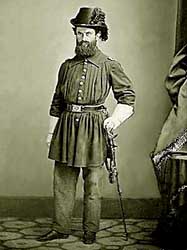 |
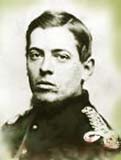 |
Major George W. Tew |
In closing this sketch of the First Rhode Island Regiment, it seems fitting that the history of its distinguished commander should be given. Colonel AMBROSE EVERETTE (EVERTS) BURNSIDE is of Scotch descent, and was born at Liberty, Union county, Indiana, May 23rd, 1824. After completing his elementary education, he entered the West Point Military Academy, and graduated with distinction, in the Artillery, in 1847. The following year, he received a full second lieutenancy, and was attached to the third regiment of artillery. The Mexican War was at this time in active operation, and soon after graduating, Lieutenant Burnside joined General Scott. On the proclamation of peace, he was ordered to Fort Adams, Newport, R. I., where lie remained until the spring of 1849, when he was ordered to join Bragg, in New Mexico, and received the appointment of first lieutenant in the famous battery of that officer. In the new service to which he was called, he gained reputation for coolness and bravery. In the winter of 1850-51, he filled the office of' quartermaster of the boundary commission, and in the following September, with an escort of only three men, made a perilous journey to Washington, as bearer of dispatches an enterprise accomplished in seventeen days, for which he received the thanks of the War Department. Returning from his service in New Mexico, to Newport, he was married April 27th, 1852, to Miss Mary Bishop, of Providence. Soon after, he resigned his commission and removed to Bristol, R. I., where he engaged in the manufacture of a breech-loading rifle of his own invention. Failing to obtain a government contract which he had reason to expect, he was compelled to give up the business entirely. In 1858 he went to Chicago, and was appointed cashier in the land department of the Illinois Central Railroad. Subsequently he was made treasurer of the railroad company, and took up his residence in New York.
While residing in Bristol, Colonel Burnside was chosen Major General of the Rhode Island State Militia, and by his urbane manners and soldierly qualities obtained a wide popularity, and when the Rebellion broke out he was at once selected as the most suitable officer to lead the First Rhode Island Regiment to the defense of Washington. The call of Governor Sprague was promptly responded to by the people of Rhode Island. Moved by the purest patriotism, Colonel Burnside left his business, and in an hour after receiving the dispatch notifying him of his appointment, he was on his way back to Providence, where he was received with the warmest enthusiasm. Immediately on his arrival at Washington he was tendered the commission of brigadier general, which, from a sense of duty to his Regiment and the State, he declined; but afterwards, before the army advanced into Virginia, he was urged to take the command of a brigade, including the First and Second Rhode Island Regiments, as already mentioned, which he did. The gallantry and military skill displayed by Colonel Burnside, as commander of the brigade in the battle of Bull Bun, attracted the attention of the general government, and August 6th, 1861, he was promoted to the rank of brigadier general. Besides the acknowledgment of his services by his adopted State, before referred to, Brown University, at its commencement in September, 1861, conferred upon him the decree of Master of Arts, and the Phi Beta Kappa Society elected him an honorary member of that body.
When, in the autumn of 1861, the North Carolina expedition was projected, General Burnside was placed in command. With characteristic energy, he organized the enterprise at Annapolis, Maryland, and early in January, 1862, the expedition set sail for Roanoke Island, the stronghold of the rebels in that quarter. The weather during the voyage was heavy, and on approaching Hatteras Inlet the fleet encountered a furious hurricane, which threatened speedy destruction. Three vessels were stranded and one foundered; but providentially only two or three lives were lost, by the accidental swamping of a lifeboat. Amidst all the perils and excitement of the hour. General Burnside rose superior to circumstances, and by the promptness of his action, and calmness of his manner, imparted confidence and courage to his men. At length the victory over the elements was complete, and the Federal forces affected a landing. On the 7th and 8th of February, the battle of Roanoke Island was fought, and the rebels totally defeated, with the loss of six forts and batteries, forty cannon, upwards of two thousand prisoners of war, and three thousand stands of arms. Shortly after, Commodore Goldsborough sent a fleet of gunboats up the Pasquotank and Chowan rivers, and Elizabeth City, Hertford, Edenton and Plymouth fell into the hands of the Union troops. On the 14th of March New Berne was captured, after a hardly contested battle of four hours. Here the 4th Rhode Island Regiment won laurels by a fierce bayonet charge, which decided the contest. On the 23d March, possession was taken of Morehead City, April 26th, after a bombardment of ten hours, Fort Macon surrendered, and to the 5th Rhode Island Regiment was assigned the honor of taking possession. |
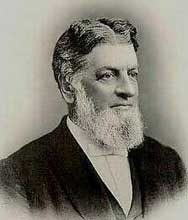 |
 |
 |
Rev. Augustus P. Woodbury |
The successes of General Burnside were received in Rhode Island with the liveliest demonstrations of joy. The General Assembly voted him an elegant sword in testimony of the appreciation of his eminent services, which was presented to him at New Berne, June 20th, with appropriate ceremonies, in the presence of 16,000 troops. The General continued to operate in North Carolina until the latter part of June, when, for the purpose of cooperating with General McClellan, who was about to withdraw from the Peninsula, he set out with 7,000 men for Newport News, where he was joined by a division from Hilton Head under the command of General Isaac I. Stevens, and proceeded to Fredericksburg, to take the place of General McDowell, who had been sent to the aid of Pope. After the defeat of Pope in the Second battle of Bull Run, General Burnside, with his Ninth Corps, joined McClellan to drive Lee out of Maryland. He entered Frederick City September 12th, and was enthusiastically received. On the 14th he fought the successful Battle of South Mountain, and on the 17th fought again at Antietam Bridge, beating back the enemy at every point, and crowning the day with one of the most brilliant achievements of the war. On the 7th November General Burnside succeeded General McClellan in the command of the Army of the Potomac. On the 13th of December the Battle of Fredericksburg took place, and though unsuccessful, the attempt was not an error, nor a failure of his leadership, but rather an accident of circumstance and the failure of General Franklin, his subordinate, to carry out his mission.
Afterwards the position of General Burnside was one of great trial and perplexity. But amidst all the vexations and disappointments to which he was unfairly subjected, he bore himself with characteristic equanimity. On the 26th of January, 1863, for reasons honorable to himself, General Burnside was, at his own request, relieved from his unsought and undesired position, and was soon after assigned to the command of the Department of the Ohio. During his administration of the affairs of this Department, he arrested and tried by court martial Mr. C. C. Vallandigham, for uttering treasonable sentiments against the Government. The prisoner was found guilty and was sent across the lines to his sympathizing friends in the South. While engaged in important military operations in Tennessee, which resulted in the capture of Knoxville, Cumberland Gap, and all important points in East Tennessee, General Burnside proposed to the authorities at Washington a plan of movements substantially such as were afterwards adopted by General Sherman in his famous "March to the Sea", and which, had they been sanctioned, would probably have precipitated the downfall of the rebellion by at least a year. During the campaign he gained victory at the Battles of Blue Spring and Campbell's Station, and resisted the siege of Knoxville. After retiring from the duties of the Department he returned to the East.
Early in 1864, General Burnside completed the re-organization of the Ninth Corps, and joined General Grant in the final movement of the Army of the Potomac towards Richmond. By a forced march he arrived on the field on the first day of the Battle of the Wilderness, in time to strengthen General Grant. Since General Grant had originally planned to attack the rebels in Virginia with two separate armies, to avoid further complications with General Meade, Burnside seeing the advantage of consolidating the 9th Corps with the Army of the Potomac, and willing to relieve General Grant from any embarrassment in relation to the command, generously waived his rank, and volunteered to subordinate himself to General Meade. On the 16th of June, the 9th Corps was in position before Petersburg, and on the following day carried the enemy's works in its front. On the 18th, it participated in a still more sanguinary fight, and the line of the Corps was pushed to within one hundred yards of the rebel defenses.
The most marked feature of the siege was the mining of the enemy's works. The plan was proposed by Lieutenant-Colonel Henry Pleasants, of the 48th Pennsylvania regiment of volunteers, an experienced miner, approved by General Burnside, and finally authorized by General Meade. General Burnside's arrangements were judiciously made to insure success, but owing to a reversing of the programming at the last moment by General Meade, and other unavoidable causes which delayed the springing of the mine beyond the appointed time, and the want of sufficient support, after the assaulting force of the 9th Corps had all been put in, the enterprise failed. Of course, great disappointment was felt, and by no one more keenly than by General Burnside; but he had the satisfaction, in the midst of his sorrow, of knowing that no fault justly lay at his door. A Military Court of Inquiry, composed of officers personally interested in the results of an investigation, did indeed censure him for not doing what the testimony shows to have been an impossible thing; but the Congressional Committee on the Conduct of the War, after a careful examination of the subject, exonerated him entirely from blame, because the Military Court of Inquiry also determined that Burnside did all he could to insure success in the field. They say in their report, that the disastrous result of the assault, "is mainly attributable to the fact that the plans and suggestions of the general [Burnside] who had devoted his attention for so long a time to the subject, who had carried out to a successful completion the project of mining the enemy's works, and who had carefully selected and drilled his troops for the purpose of securing whatever advantages might be attainable from the explosion of the mine, should have been so entirely disregarded by a general [Meade] who had evinced no faith in the successful prosecution of that work, had aided it by no countenance or open approval, and had assumed the entire direction and control only when it was completed, and the time had come for reaping any advantages that might be derived from it". This opinion will be endorsed by every impartial student of history.
After this unsuccessful assault, General Burnside tendered his resignation to General Grant, who refused to accept it, and gave him twenty days leave of absence, which he improved by visiting his home and friends in the East, where he received from all quarters the most gratifying tokens of unabated confidence and esteem. In the course of the subsequent winter he repeatedly tendered his resignation to the President, who repeatedly refused to accept it. He however did no further military duty, though his voice and influence were constantly employed on behalf of the army and the government; and April 15th, 1865, he again tendered his resignation, which was accepted by the War Department.
No commander ever more endeared himself to his men than did General Burnside. His exact justice secured their unlimited confidence, his kindness of heart won their love. Their comfort and welfare were constantly in his thoughts, and the humblest private felt sure that his petition would not be rejected without due consideration. Unselfish and un-ambitious of popular applause; frank, generous and manly in all the qualities of life; a patriot and Christian in his spirit; the years devoted to the suppression of the Rebellion were marked by entire consecration to the interests of his country.
After the war was ended he was engaged for a considerable time in business, both in New England and the West. On the 30th of March, 1866 he was nominated by the Republican Party for the office of Gov the 26th of January, 1876. He entered upon his duties on the 4th of March following. He was re-elected on the 9th of June, 1880, to serve a second term, beginning March 4, 1881. The first year of his official life was marked by a very severe bereavement in the death of Mrs. Burnside, who deceased March 10, 1876.
His public career was marked by a faithful and assiduous attention to all the most important matters of legislation. Among others he was especially interested in the application of the Monroe Doctrine; in the construction of the Panama Canal; the increased efficiency of the army; and the promotion of public education.
He died in Bristol from an acute attack of Angina Pectoris, September 13, 1881. The funeral took place in Providence on the 16th of September and was attended by large numbers of his comrades, members of the United States Senate and of the State government, and a vast concourse of citizens. Both in private and in public life he was greatly beloved for his unswerving loyalty, his high sense of honor, his fine qualities as a soldier and a man, and his unparalleled magnanimity.—authored by Elisha Dyer Jr., 1893—transcribed and edited by Gregg A. Mierka, [PDC RI SUVCW Governors Elisha Dyer Camp No. 7—PCC, RI MOLLUS] 1993 RI SUVCW Elisha Dyer Camp No. 7—2003, RI Grand Army of the Republic Civil War Museum, and the Cranston Historical Society—original copyright © 1993. |
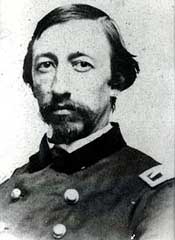 |
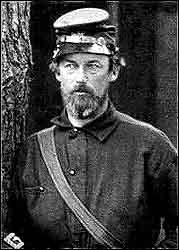 |
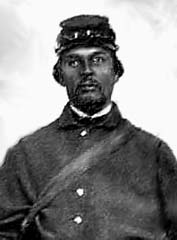 |
Officers Left to Right: |
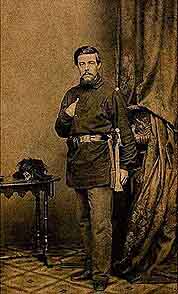 |
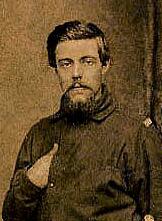 |
Captain Charles William Henry Day, Commander of Company H, 1st Regiment RIVI. Born in Scituate Rhode Island, 1837 and died 1932. Day was living in Providence when the war began. He enrolled for duty on April 17, 1861, three days after the fall of Fort Sumter. He was mustered to duty in the 1st RI Volunteer Infantry upon receiving his commission by Governor Sprague, for three months service. Captain Day led Co. H with distinction during the First Battle of Bull Run and the bloody encounter with the rebels on Mathews Hill, July 21st, 1861. He was discharged from the 1st RIVI on August 2, 1861, then re-enlisted in the 3rd Regiment RI Volunteer Heavy Artillery for three additional years service in defense of the Union. He was made a Captain at Fort Hamilton and then promoted to Major at James Island, against Charleston, South Carolina, before his service ended. |

 |


THE 1st RHODE ISLAND VOLUNTEERS COLOR & GUIDON BEARER THE 1st RIVI NATIONAL COLORS AND R.I. STATE COLORS

OF THE GRAND OLD FELLOWS IN BLUE of Rhode Island's Oldest Civil War Organizations
CIVIL WAR MUSEUM & LIBRARY

|